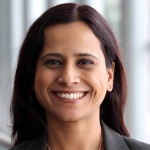How will you help break the bias in career fields historically dominated by men?
Caroline O’Reilly is general manager of analytics based in Dublin, Ireland:
We need to start breaking the bias from a very young age. I started this with my own two daughters—talking with them from an early age about maths and science and how they are intertwined in many aspects of their lives. I’ve been talking to children in our Dublin primary schools about how working in tech opens up opportunities to travel and work internationally, gain independence, and work on diverse international teams.
I’m deeply grateful for initiatives like the partnership we announced last month with Technological University Dublin (TU Dublin). Our goal is to equip early talent with the skills and know-how to pursue a career in technology and also encourage and support underrepresented groups to consider careers in STEM. The partnership will be an opportunity to focus on workforce development, collaborate on innovation with the next generation of engineers, and continue to engage with our local community.
How will you break the bias to decrease the gender pay gap?
Melissa Bowden is senior director, people partner and organizational effectiveness, APJ, based in Sydney, Australia:
There is a vast amount of evidence that indicates the key drivers of the gender pay gap include gender discrimination, occupational segregation, and years not working due to interruptions—such as child care and caring for elderly family members. I am committed to address this by doing the following: increase pay transparency and report on gaps, undertake pay gap audits and act on findings, improve work-life balance, increase availability of flexible work, change workplace culture and address unconscious bias, and enhance availability of shared parental leave.
Gender segregation across the industry highlights that we need to focus on increasing the share of women in leadership positions. Evidence shows that by doing so, we can drive greater employee engagement and business performance.
How will you break the bias in the workplace to better support caregivers?
Lindsay Eichenlaub is senior instructional designer of talent experience learning design based in the San Francisco Bay Area. She’s also a lead for the Caregivers of People With Special Needs (CoPS) Employee Belonging Council (EBC):
Growing up, my stay-at-home mom struggled with her transition back into the workforce. Knowing both motherhood and my career were important to me, I refused to accept the old way of thinking.
Now, as a mom to a disabled toddler, joining a company that aligned with my personal values was my biggest driver. I feel fortunate to be part of an organization that truly recognizes its employees as the whole human they bring to work.
I try to break the bias by talking about it. As much as I love my career, I’m a mom first, and I want my co-workers to know that. Outside of work, I mentor moms transitioning back into the workforce through an organization called The Mom Project. I’m constantly reassuring moms that it’s OK to have both!
Thanks to organizations like Workday and The Mom Project, the conversation about caregivers in the workplace is no longer taboo.
Anubha Samuel is a support analyst based in Auckland, New Zealand. She also weighed in on the question of providing better support to caregivers:
Historically, women had the enormous job of being a homemaker, taking care of children, cooking, caring for the elders at home, and so on. Decades later, despite immense change in the work environment being more friendly and accommodating, women still face biases.
All of us are fully aware of the intricacies of work-life balance. Many of us have children and/or elderly family members to care for. It can be physically and emotionally draining to juggle everything in a day.
While companies understand this, unconscious biases do still creep in. For example, when it comes to promotions, it isn’t fair to choose the worker who has not taken a single day off over somebody just as competent who may have had to take intermittent time off to care for a family member. Or, when considering an employee’s leave or a flexible work arrangement for caregiving reasons, people leaders should remember that employees are Workday’s No. 1 core value.
To mitigate for bias, it is important to be mindful of the assumptions that people may have about gender and caregiving.










